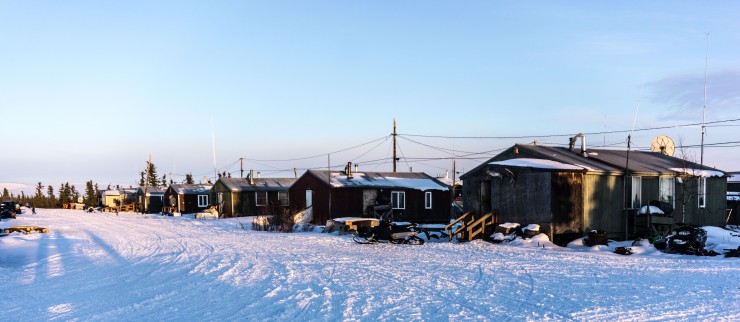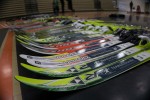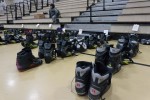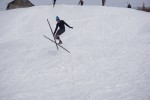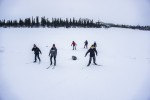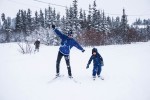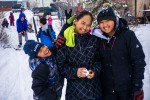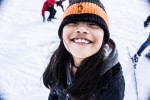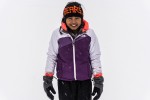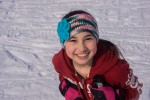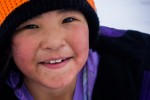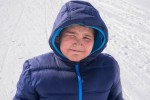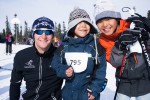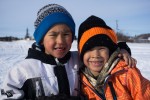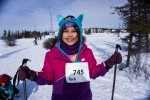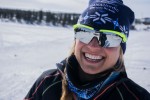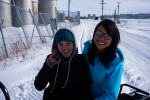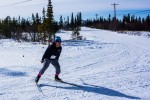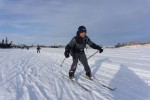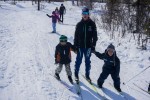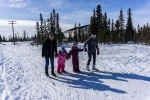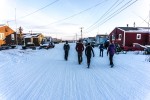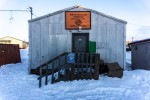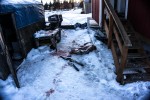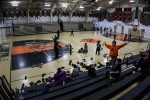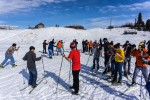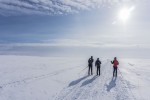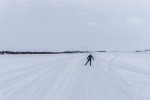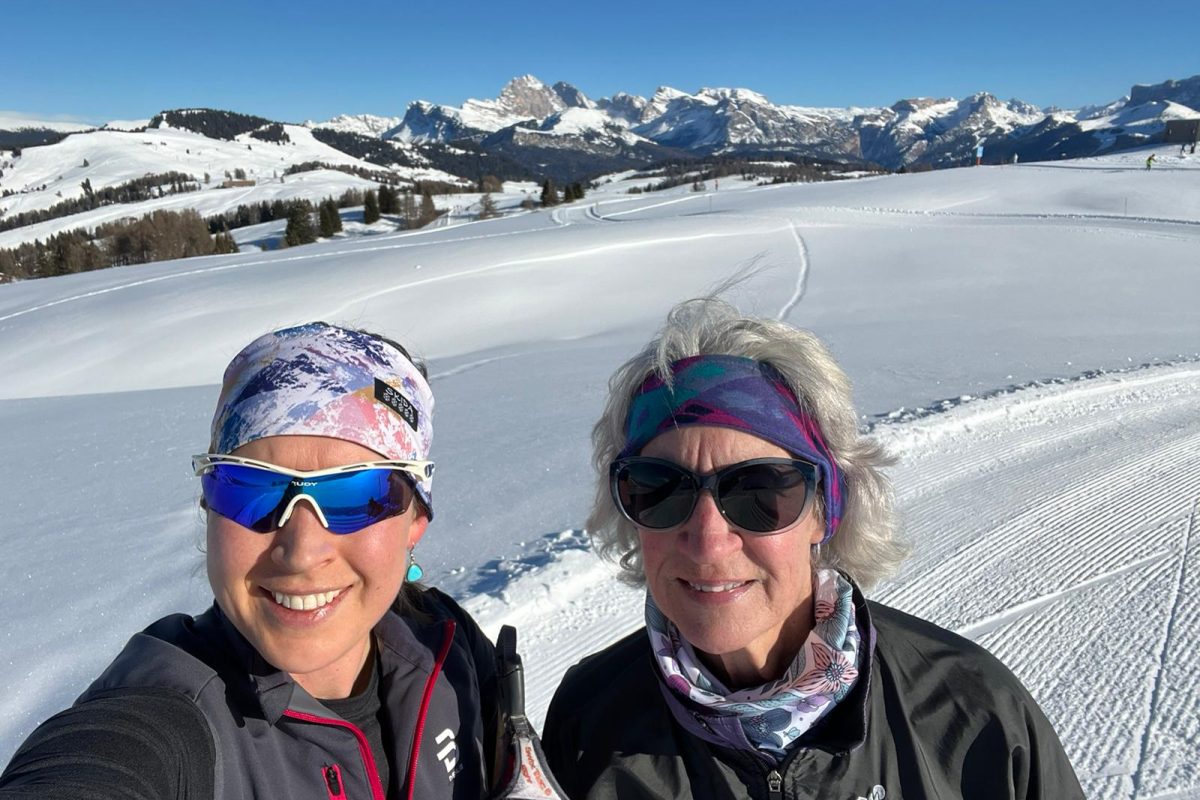NANANordic has been covered extensively by FasterSkier in the past, most recently in May 2014. Now in its fourth year, NANANordic sends elite cross-country ski racers to Alaskan villages to teach skiing to school children, with the goal that skiing become a lifestyle activity in rural Alaska.
Seth Adams, a FasterSkier contributor who lives in Fairbanks, Alaska, joined the ranks of the volunteers this spring. Some of his photos from NANANordic in Noorvik appeared on this site in April. All opinions expressed here are his own.
I don’t remember what I said.
“Well, no. Not exactly,” Lars Flora responded, sounding pained. “That’s a common misconception among city Alaskans about the villages.”
I was interviewing Lars for an article I wrote last year about NANANordic, a program that Lars began in 2012 to teach skiing to kids in remote Alaskan villages.
As I write these words, a year after that interview with Lars, whatever I was wrong about wasn’t important enough to me to remember. But the take-home point was important to me. Although Lars was trying to be nice, the message was loud and clear — I thought I knew something, but I didn’t know anything. And I was part of the problem.
I’m from Fairbanks, Alaska, the state’s second-largest city. Although Alaska’s cities contain most of the state’s population, there are far more villages than there are cities. And Alaska’s cities are majority white population (like me), while the villages are almost-exclusively Alaska Native.
I’d never really been to any of the villages. And among white, city Alaskans, that is not at all uncommon. Most of the villages aren’t accessible by road — the only way in or out is by snowmobile, airplane or boat. And without a specific reason to go to one of the villages, most people don’t. City Alaskans often view them as grim places — devoid of economy or diversion, where alcoholism and domestic violence are more the rule than the exception.
But in spite of our lack of firsthand experience with village life and our negative opinion of what we think we know, city Alaskans tend to not be indifferent to the villages. We see these places as an integral part of our state identity and their existence as a part of the Alaskan experience.
We see these places as an integral part of our state identity and their existence as a part of the Alaskan experience.
And so when I was told that some of my preconceived ideas were wrong, it cut deep. What else didn’t I know? I decided it was time to see for myself. Besides, volunteering with NANANordic sounded fun.
Noorvik
After a hectic schedule of personal travel, I had a cold. I met my fellow coaches in the Anchorage airport at a truly uncivilized hour on the morning of April 5 to catch our flight to Kotzebue. There were a gaggle of NANANordic volunteers swarming the check-in line, all headed to different villages in the Northwest Arctic region.
I would be headed to Noorvik with four other coaches — three veterans of NANANordic: Alaska Pacific University’s Lauren Fritz, Lauren’s boyfriend and Australian National Team member Paul Kovacs, and U.S. Paralympics Nordic Development Coach Robert Rosser. And one other newbie — 15 year-old Anchorage high school skiing standout Luke Jager.
We boarded an Alaska Airlines 737-combi (half of the passenger compartment is converted to cargo space) for the hour-and-a-half flight to Kotzebue. After some shuffling and waiting for winds to calm, we settled into an eight-seater Bering Air single-engine prop plane for the 30-minute flight from Kotzebue to Noorvik. After a remarkably smooth landing amidst the whipping wind in Noorvik, we loaded our bags into a van driven by the school principal.
“The skiers are here!” the kids exclaimed as we carried our bags into the school. The school would be our home for the rest of the week. We looked around approvingly.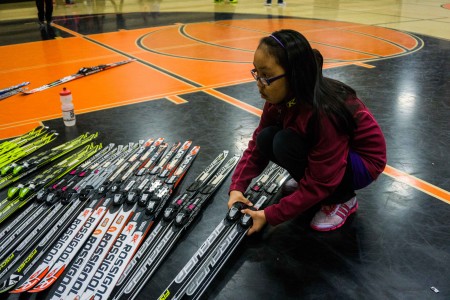
In the afternoon we went out to ski around and get oriented. Luke stood with his skis braced against the wind. He straightened his skis and began accelerating across the icy school yard as the wind pushed him backwards.
At some point during the school day, each teacher brought every kid in the school to the gym to ski. I don’t know whether or not they were forced to ski with us — but it didn’t matter seem to matter, because almost to a student, including the surly high schoolers, they wanted to.
Personally, the naturally athletic kids that easily picked up skiing weren’t the most rewarding to work with; it was the strugglers that were the most interesting.
Take a first-grader, we’ll call him Casey, as a case study. During his first time on skis, Paul and I stayed back with him, and at the end of the session we both agreed that our backs were sore from repeatedly helping him onto his feet. He could stand for only seconds at a time and asking him to untangle himself once on the ground and get back on his feet on his own seemed a bit like asking him to fly the space shuttle. There were tears and there was whimpering.
But after school, when returning to ski was their own prerogative, Casey was back. As were many other kids that we did not expect to see. Out of the 190 kids in the school, over 60 were neatly lined-up outside the gymnasium door to ski again — fully one third of the school was back to ski for a second time that day. You would definitely not see this in Fairbanks or Anchorage.
… One third of the school was back to ski for a second time that day. You would definitely not see this in Fairbanks or Anchorage.
Casey constantly asked for help with everything. Like many of the kids, he was naturally quiet and rarely used words, expressing many of his emergencies in pantomime. But there seemed to be no minimum to how ridiculous his emergencies might be. One time, he frantically gestured at me that his sock had come off and stayed in his boot after he took the boot off.
“So pull it out and put it back on,” I said.
He held up his gloved hand in alarm, to show he could not possibly remove the sock from the boot by himself, since he was hamstrung by the glove.

“Take the glove off, Casey,” I said with a laugh. He shrugged in disappointment, and did it. He was perfectly capable of everything everyone else was, but somehow being helped filled a need for him.
Casey probably isn’t going to become a heroic story of having won the race or landed a 360. But he kept skiing all week, and although he never outwardly seemed to love it, at the end of each session he unfailingly asked when he could ski again. As did many of the others. The bottled-up enthusiasm for skiing and for being outdoors was something that we all found remarkable.
At the end of each day we were exhausted. We skied for at least nine hours a day, usually no-pole and in a rush to tend to one “emergency” or another. Then it was at the end of each day that we had the biggest group. We often led the whole group fairly far away from the school, with the smallest kids desperate to keep up with the biggest. At the end of the session, getting everyone back was a huge chore.
Occasionally the frayed ends of Paul’s nerves would show, which resulted in me calling him “the cranky Australian.” But I could understand why was frazzled. We’d taken the kids out to the Kobuk River on the far side of town, and they were scattered as far as we could see. It was getting late, but Luke, who is a high schooler himself, was hitting a jump with a group of older kids on the far side of the river. Paul’s jaw was repeatedly clenching and unclenching.
Right then a woman and two kids pulled up on a snowmobile and told one of the kids to get on. Another kid grabbed onto the back of the sled and got towed, face dragging through the snow as he held tight to the snowmachine, until the woman realized he was back there and scolded him off. He stood up grinning a mischievous grin.
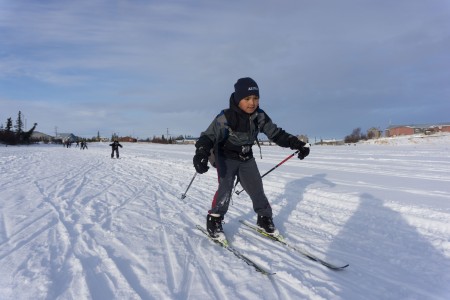 I didn’t know who the woman was, didn’t remember the name of the kid she’d scooped, and was unsure if we’d get the skis and boots back. I looked at Paul and shrugged — we were visitors in a strange land, and our job was to teach skiing.
I didn’t know who the woman was, didn’t remember the name of the kid she’d scooped, and was unsure if we’d get the skis and boots back. I looked at Paul and shrugged — we were visitors in a strange land, and our job was to teach skiing.
It’s difficult to overstate the tightness of the social fabric Noorvik. Nearly everyone is related in some way, and there is no need to be accountable for where the kids are, since everyone watches out for everyone. But this was hard for us to remember; the idea that small kids can run loose through a town and be perfectly safe is not a part of our cultural experience. We reminded ourselves that we were the only ones that were overwhelmed; for everyone else this was daily life. Except that usually they don’t have skis.
“The little kids won’t head back to the school until you guys stop hitting that jump and head back yourselves,” I told the high schoolers, trying not to beg. “Do you mind just heading back? Because otherwise we’ll be out here all night getting the small kids back.”
The count of skis and boots at the end of the day was exactly right. No equipment was missing. The woman must have returned her child’s skis and boots.
The week was a bit of a blur of chasing kids, clicking boots into skis, offering encouragement, and answering endless questions about when the next chance to ski would be. But being in Noorvik I was reminded of the conversation I’d had with Lars. I looked around, waiting to have one of my preconceived notions shattered in lightning bolt epiphany.
Noorvik wasn’t overly different from what I’d expected. Life there isn’t easy, but it wasn’t as tough as I’d imagined. Perhaps it was just seeing it that mattered and seeing how tight the social bonds are, witnessing how the older siblings watch out for the younger ones with no trace of resentment, and that all the adults in town are essentially guardians for all the kids.
Noorvik wasn’t overly different from what I’d expected. Life there isn’t easy, but it wasn’t as tough as I’d imagined.
“I like what you’re doing with our kids,” one man told me as he walked past.
A couple of hours later when he walked back by, I invited him to join us.
“No,” he replied, then, apologetically, “I’m drinking now.” The kids continued to ski in excited circles all around us.
Noorvik is a dry village, which means any possession of alcohol is prohibited. He excused himself, and I invited him back another day, but he never came. The kids, however, were all hooked on skiing. And they kept coming back.
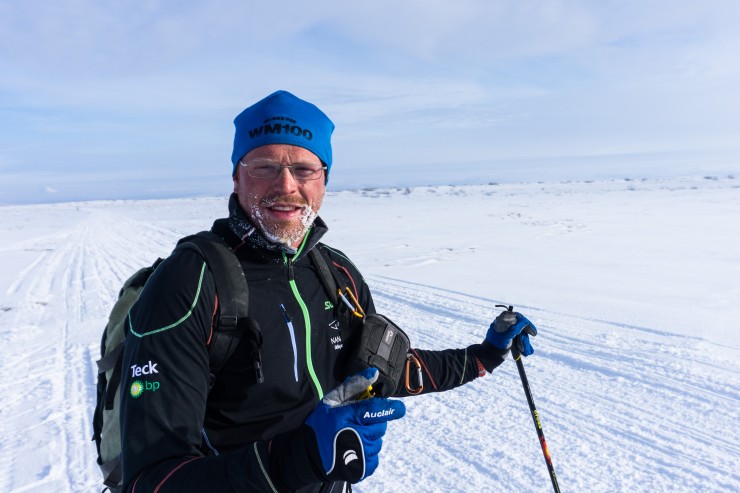
At the end of the week, all five coaches skied 55-kilometers from Noorvik to the village of Selawik. Read about it and see pictures on Seth’s personal blog.


